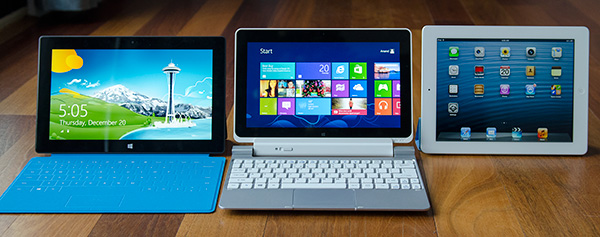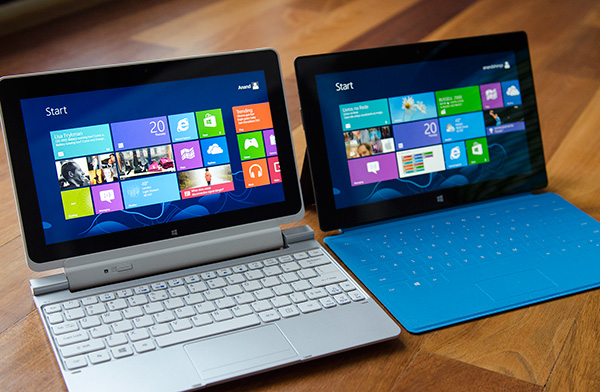The Clover Trail (Atom Z2760) Review: Acer's W510 Tested
by Anand Lal Shimpi on December 20, 2012 10:34 AM ESTFinal Words
This is a tricky conclusion to write, because as always there’s a lot of concluding that has to be done. On the one hand, we have Intel’s Clover Trail platform. On the other we have Acer’s Iconia W510 tablet itself. And on a magical third hand we have to conclude on behalf of Microsoft’s Windows 8.
I’ll start with the Intel hand.
Clover Trail is good. I only have NVIDIA’s Tegra 3 to compare it to at this point, and there Intel wins hands down. Performance is clearly better, tasks complete quicker, the modern UI is even more responsive. Power efficiency, once again, seems like a non-issue. The W510 in particular uses a smaller battery than most, but its battery life per watt-hour is very similar to Surface RT. Samsung’s ATIV Smart PC actually seems to be a better showcase of what Clover Trail can do from a power efficiency standpoint. If we haven’t squashed the notion of Intel being unable to build low power SoCs by now, Clover Trail should help drive the nail into that coffin. The debate is no longer about whether or not Intel can build something competitive with ARM on the power front, but whether Intel can execute quickly enough to defend its marketshare.
Backwards compatibility is a hit or miss advantage for Clover Trail. If you use it for the flexibility of being able to run nearly every Windows application available, then you’ll be pleased. Small apps that I’ve relied on for years just run without issue on Clover Trail. I don’t need to find modern replacements, my library of tools just work. I suspect this advantage will appeal in enterprise markets where custom applications are often on very long development cycles.
However if you’re expecting to be able to enjoy a similar experience to what you currently have on your Ultrabook, you’ll be sorely disappointed. Atom isn’t Core, the performance delta is dramatic. The Windows 8 desktop experience on Clover Trail is like using a notebook from several years ago. Performance is at least consistent thanks to the lack of any mechanical storage, but running intense workloads on the platform is hardly quick. Being quicker than most of the ARM platforms on the market today isn’t enough, Intel has to deliver a good experience across all applications. The experience is further hampered by sub-par UI performance in desktop mode. It actually feels like Tegra 3/Surface RT are faster when it comes to desktop UI performance. This highlights a disturbing trend within Intel’s ultra mobile products. The company continues to under-spec its ultra mobile GPUs. If Intel is really serious about both the tablet and smartphone markets it needs to build the best SoCs in the world, and that means delivering the best CPU and GPU performance.
I was impressed by the unique combination of closed box tablet OS and flexible/customizable desktop OS that Windows RT delivered. Windows 8 on Clover Trail takes that feeling to a completely new level. Being able to install and run nearly any weird, old application in one breath and then switch over to a fairly well optimized tablet experience in the next is pretty awesome. Where the experience falls short is really the performance of desktop mode and most of the applications I’d like to run unfortunately. Scrolling isn’t smooth, response time is pretty bad if you’re running anything demanding. You have to keep in mind that, at best, we’re talking about mainstream notebook CPU performance from around 2005. Until Intel revs Atom (which should happen next year, thankfully enough), the backwards compatibility story won’t be as awesome as it could be.
On the Acer side of things, the dock experience (particularly the troubles I had with the clickpad) also contributes to the W510 not being the perfect tablet+notebook in one. As a standalone tablet I prefer the W510, it’s got a great form factor and I love its light weight. As a docked system however, Samsung’s ATIV Smart PC seems to be the better choice.
The W510 itself is well executed, but overall the experience seemed a bit less polished than with Microsoft’s Surface RT. This is where things get really complicated. I want the SoC from the W510 but in the overall device experience that Microsoft’s Surface delivered. I even think Acer might have a form factor advantage in the W510 since it’s just so light. It’s a shame that the only x86 Surface device will be the bigger Pro model.
Ultimately my conclusion about the W510 in particular is a lot like what I felt about Surface RT. You know it’s going to be made obsolete in less than a year’s time, so you have to be ok with that fact if you’re going to pull the trigger today. Even then, the experience isn’t perfect. Microsoft still needs some updating on the Windows side to address bugs and quirks with the OS. Performance isn’t as big of a problem on the W510 as it was on Surface RT, but I’d still like to see more on that front as well.
Much of the same goes for Windows 8. Although its execution hasn’t been perfect, I really do like the OS and I see a lot of potential in these converged notebook/tablet devices. Especially for users who travel a lot, being able to have the best of both worlds in an extremely portable device is a wonderful dream. I think Microsoft has the right vision, but what we need to see are more revs to the OS to fully realize it. The real question is whether or not Microsoft will be able to deliver significant updates to Windows 8 as quickly as the market needs it.













104 Comments
View All Comments
MonkeyPaw - Friday, December 21, 2012 - link
I sampled the 32GB version not long ago.There was no recovery partition (they give you 4 DVDs), but when it's all said and done, about half the space is consumed by the base install. Once you add a modest selection of media and a few MS apps (which can be rather large), you are looking at a few GB of free space remaining.skiboysteve - Friday, December 21, 2012 - link
Do people really need the installed paid for versions of office? The free online web apps are completely amazing. Way way better than google docs... They are just about full versions of office. Only thing I could think of is for airplane tripszeo - Monday, December 31, 2012 - link
Only the RT version has Office included by default, and it's the more basic Home and Student 2013 RT version, regular W8 depends on the system maker as to whether a copy of Office will be included or not... Like, I believe, Lenovo offers full Office with the Lenovo Thinkpad Tablet 2 for example.RT though is a bit stripped down from W8 and so is a bit smaller install than regular W8/Pro, even with Office included.
Regular W8 tablets though are suppose to start with 64GB drives, they just offer 32GB for lower entry price point and it's only the RT tablets that are suppose to start with 32GB.
This is mainly due to the pricing structure used by most tablet makers, most charge for capacity even though the actual capacity doesn't cost the price difference. Like the $249 Nexus 7 doesn't cost $50 more than the $199 Nexus 7 to add that extra capacity, but this is how they improve their profit margins when offering higher specs and can afford to lower profit margins for the lower spec versions.
All Windows tablets though should offer Micro/SD, though for now you can't install apps anywhere but the main drive but you can put just about everything else on the memory card for extra capacity.
While higher end tablets should offer drives up to 128GB and some will offer hard drives in the docks, like the Asus Vivo Book has a 500GB HDD in the keyboard dock.
CaptchaIsEvil - Friday, December 21, 2012 - link
So this is what it's like to depend on far flung "OEMs" to build a product that will attract an audience.MS is depending on OEMs who use weak drivers resulting in poor user experience and that build substandard hardware.
Just like with Android, Samsung will be the only OEM to step up to the plate and dedicate the resources to compete in the big leagues. It won't be Acer and it won't be the commoditizers at HP or DELL (parts bin assemblers).
MS better hope it happens soon.
zeo - Monday, December 31, 2012 - link
Weak drivers are a issue, but Intel will be moving back to a GMA based on their own technology instead of Imagination's with the 22nm ATOM updates.There may still be some driver issues but support for their own hardware is much better and we'll see a return of full 64bit and Linux support.
The actual GMA is suppose to be based on the Ivy Bridge HD4000, just scaled down from 16 execution units to 4, and that should mean better developed drivers from the start as well.
It'll just be either late Q3 or around Q4 2013 until we see products based on the update start to come out.
nofumble62 - Friday, December 21, 2012 - link
fast, run everything, and have lot of storage.Tablet is a fad, and will fade away.
kyuu - Friday, December 21, 2012 - link
How's the weather over there in Denial Land?nofumble62 - Friday, December 21, 2012 - link
Great- warm and toasty over my i7-3770.In the drawer, there is an iPad3 and a Kindle Fire. They are nice to play with for a short while, but I am now back to my 24" IPS and keyboards.
aliasfox - Sunday, December 23, 2012 - link
And here's the alternate scenario: I'm on my iPad1 At my parents' house, and after the second day of regular use I'm still at 42% battery life, and I'm doing the same thing as you, commenting on a forum.Is it slow as heck? Yes. Is it useful for a whole lot besides for web surfing, videos, and short writing like this? No, not really. Is web surfing, videos, and short writing like this a significant portion of my daily web life? Yes. Do I appreciate the fact that I can get two and a half days of usable battery life in a package about half the weight of an ultrabook? Absolutely. Have regretted I buying and using this for the past two and a half years? Aside from abysmal resale value, not at all.
My Mac Pro doesn't get much use besides for Netflix watching on my TV, so for my usage scenario, I'm cool with a tablet. I'll throw in shipping cost if you want to send me your iPad3 though, I'll give it a good home.
Death666Angel - Saturday, December 22, 2012 - link
Hey!Good article. Just wanted to say that the charger connector is pretty much similar (the same?) my Travelmate 8172 has (just in white whereas mine is in black). On that charger, I can use it to set the orientation of the charger, it helps in crowded sockets. And guess it might save Acer a few cents of cost. Anyway, I like it a lot. :D